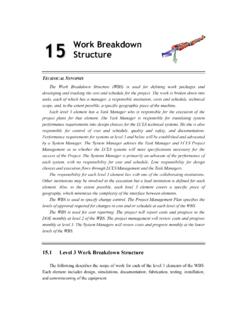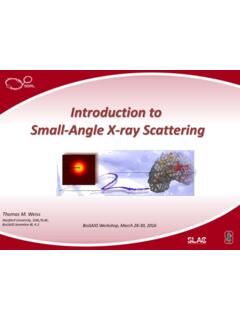Transcription of The Scale of Things – Nanometers and More
1 Red blood cells(~7-8 m) Things NaturalThings NaturalThings ManmadeThings ManmadeFly ash~ 10-20 mHead of a pin1-2 mmQuantum corral of 48 iron atoms on copper surfacepositioned one at a time with an STM tipCorral diameter 14 nmHuman hair~ 60-120 m wideAnt~ 5 mmDust mite200 mATP synthase~10 nm diameterNanotube electrodeCarbon nanotube~ nm diameterOOOOOOOOOOOOOOSOSOSOSOSOSOSOSPOO The ChallengeFabricate and combine nanoscale building blocks to make useful devices, , a photosynthetic reaction center with integral semiconductor nm1 nanometer (nm) m10 m100 nm1 micrometer ( m) mm10 mm100 m1 millimeter (mm)1 cm10 mm10-2m10-3m10-4m10-5m10-6m10-7m10-8m10- 9m10-10mVisibleNanoworld1,000 Nanometers = InfraredUltravioletMicrowaveSoft x-ray1,000,000 Nanometers = Zone plate x-ray lens Outer ring spacing ~35 nmOffice of Basic Energy SciencesOffice of Science, DOEV ersion 05-26-06, pmdThe Scale of Things The Scale of Things Nanometers and MoreNanometers and MoreMicroElectroMechanical(MEMS) devices10 -100 m wideRed blood cellsPollen grainCarbon buckyball~1 nm diameterSelf-assembled,Nature-inspired structureMany 10s of nmAtoms of siliconspacing nmDNA~2-1/2 nm diameterNanoscale materials are of considerable scientific interest because some material properties can change at this Scale .
2 These changes challenge our understanding of hazards, and our ability to anticipate, recognize, evaluate, and control potential health, safety, and environmental risks. This course will provide information on the special hazards that may be associated with the handling of free or unbound engineered nanoparticles (UNP), and describe SLAC policies and controls for managing environmental, safety, and health concerns associated with laboratory activities involving staff who work with nanomaterial in laboratories (nanoparticle workers and their supervisors) must complete this course upon initial assignment. Visiting scientists, guest researchers, and other lab users who are not SLAC employees or gysubcontractors must take ES&H Course 161 or demonstrate that they understand applicable chemical hygiene principles.
3 This can be accomplished by providing acceptable proof of nanomaterial laboratory safety training from another institution or passing an exam. 3 The scope of SLAC s Nanomaterial safety plan is concerned with:Engineered nanoparticles, that is, intentionally created in contrast with natural or incidentally formed engineered nanomaterials with dimensions of less than 100 Nanometers . This definition excludes biomolecules (proteins, nucleic acids, and carbohydrates) and materials for which an occupational exposure limit (OEL), national consensus, or regulatory standard exists. Nanoscale forms of radiological materials are also excluded from this definition. Unbound engineered nanoparticles (UNP) are defined by the DOE to mean those engineered nanoparticles that, under reasonably foreseeable conditions encountered in the work, are not contained within a matrix that would be expected to prevent the nanoparticles from being separately mobile and a potential source of exposure.
4 An engineered nanoparticle dispersed and fixed within a polymer matrix, incapable, as a practical matter, of becoming airborne, would be bound , while such a particle suspended as an aerosol or in a liquid would be unbound .Humans have always been exposed to nanoscale particles via dust storms, volcanic eruptions, and other natural processes. Human activity and technological advancement has increased the variety of nanoparticles to which we are exposed. While the body is well adapted to protect itself from exposure to tiny particles, and the vast majority cause little ill effect, some can cause appreciable harm and many have chronic effects that may take years to properties of nanoparticels are often strikingly different from the properties of the same material in bulk, which forms the motivation for our scientific interest.
5 It should be noted that MSDSs may be misleading and should be considered of limited value when based on the bulk properties of the material, which has often proven to be the the new properties of nanoscale materials may be: Enhancedtoxicity of toxic materialsEnhancedtoxicity of toxic materials Newtoxicological properties not seen in bulk material Some nanoparticles may be pyrophoricor readily combustibleNanotoxicology is an emerging field, and early work was plagued by methodological problems. Our understanding is beginning to coalesce however, and we do know a great deal about how engineered nanoparticles behave. We will review some aspects to motivate our concern regarding the potential occupational hazards ofaspects to motivate our concern regarding the potential occupational hazards of are most concerned with unbound nanoparticles because they are capable of being dispersed.
6 Routes of occupational exposure to free nanoparticles can occur by inhalation, skin absorption or ingestion, and we are most concerned about inhalation where their small size allows nanoparticles to deposit in the head airways and reach deep into the lungs. 9 The toxic potential of novel nanoparticles is not easily characterized and it is difficult to generalize. A wide range of chemistries are used in nanoparticle production, especially for research purposes, and the potential structures are almost unlimited. The photomicrographs above show various morphologies of zinc oxide, each one of which may have a different potential toxicity. 10 Drivers of nanoparticle toxicity include:1. Intrinsic elemental (chemical) toxicity For usually soluble materials, individual atoms may or ions may interfere with biological systems.
7 Metals such as lead and cadmium are known to be toxic upon inhalation, ingestion or dermal exposure. Many uncoated quantum dots are intrinsically cytotoxic due to their metal content ( , lead, cadmium, selenium, etc.), and it has been suggested that their toxicity exceeds the sum of their components toxicity. Toxicological effects normally correlate to the mass of the material absorbed by the individual. 2. Morphology driven toxicity Fiber toxicity is an example; asbestos is a good example of a toxic nanomaterial, causing lung cancer and other diseases. Asbestos exists in several forms, with slight variations in shape and chemistry t i ifitlit i it Fiblitddi lfibyet significantly varying toxicity.
8 Fibrous zeolites and man-made mineral fibers are additional effects normally correlate to the number of fibers absorbed by the individual. 3. Surface reactivity driven toxicity Surface area is the key factor in catalysis and the generation of reactive oxygen species is enhanced by particles of very high surface area See next slide11high surface area. See next a given mass of particles, as the diameter of the particles decreases the number of particles increases exponentially and the specific surface area increases linearly. As particle size decreases below 10 nm, the number of molecules on the surface of the particle increases rapidly, at 4 or 5 nm roughly half of the molecules are on the surface. For a single walled carbon nanotube, every atom is on the surface.
9 There is significant evidence that many nanoparticles are uncharacteristically toxic hdt thiblkti d t thl tdtifwhen compared to their bulk properties due to the accelerated generation of reactive oxygen species that lead to bimolecule damage, inflammation, and even cell of a patient suffering from fibrosis due to crystalline silica exposureSilicosis is a dramatic example of particle size dependant toxicity. Micron sized crystalline silica particles are deposited in the upper respiratory tract with little effect. However smaller particles reach the alveolar spaces in the lungs where a cascade of effects leads to inflammation and lung in air pollution - cardiovascular disease and mortality rates: Atmospheric particle pollution from automobile exhaust seems to have a major influence on mortality, with a strong association between increased cardiopulmonary mortality and living near major roads.
10 Measurements of nanoparticle concentration near highways shows an exponential decrease over several hundreds meters away from traffic. Childhood cancers were also found to bestrongly determined by prenatal orChildhood cancers were also found to be strongly determined by prenatal or early postnatal exposure to oil-based combustion gases, primarily engine exhaust . Professional drivers show elevated rates of heart attack. The correlation between ambient particles exposure and heart disease has been established for 15 years , hospital admission for cardiovascular illness were noted to increase on days with high concentrations of particleswere noted to increase on days with high concentrations of have been shown to bypass normal body barriers to distribution in at least the following: Through intact skin sometimes Static skin application - no penetration; flexed skin - some penetration (follicle penetration).




